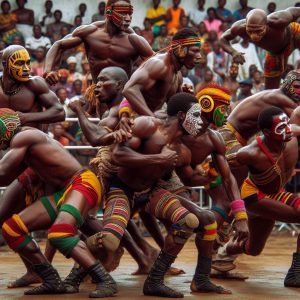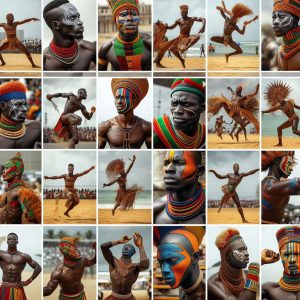Exploring the Rich Histories of African Martial Arts
From indigenous folk African Martial Arts styles to sophisticated weapon-based fighting systems, Africa possesses diversely rich martial arts histories. These traditional practices, some dating back thousands of years, carry deep cultural significance passed down through generations while retaining relevance today. In this in-depth guide, we’ll highlight examples across North, West, East, and South Africa to better appreciate the uniqueness of each style and their common emphasis on discipline, honor, and mastery of timeless techniques.
Common Threads Across African Martial Arts
Regional African martial arts arose within specific cultural contexts yet instilled core principles still applicable in modern practice:
- Cultivating total body coordination, speed, flexibility, and situational reaction skills
- Honing superior strength, stamina, pain tolerance, and mental toughness
- Strategizing to outmaneuver opponents using deception and unpredictability
- Upholding strict codes of honor, respect, and spiritual rituals
- Being applied ceremonially for cultural festivals or competitions and practically for self-defense
Wrestling Systems Build Grappling Foundations
As one of Africa’s most ubiquitous martial arts dating back over 5000 years, wrestling represents an enduring cultural cornerstone celebrating strength, courage, and skill throughout the Nile Valley down to the Cape of Good Hope across millennia. Chronicled in Egyptian hieroglyphs and human forms depicted in ancient cave paintings grappling one another, countless distinct ethnic groups incorporated wrestling into festivals and coming-of-age rituals.
Practiced barefoot atop dirt plots under the tropical sun, traditional techniques emphasize grappling prowess – leveraging speed, timing, and technical precision to off-balance and upend opponents for precious seconds sufficient to establish control and claim victory. Wrestlers expertly chain together diverse trips, throws, sweeps, locks, and pins both from standing exchanges and ground fighting scenarios once tumble into the red earth. Matches usually end on points earning pride and prestige for their community.
While varying rules and customs exist between the hundreds of individual folk styles across the continent, African wrestling ultimately transforms boys into men by testing character under physically and emotionally straining conditions similar to the hardships of traditional daily life. Developing grit, discipline, inner confidence, and social responsibility offers deeper value beyond competition outcomes.
Kushti Wrestling Across North Africa
Kushti wrestling originated in Mesopotamia over 5,000 years ago, incorporating grappling techniques that would spread through ancient Persia to North Africa. For centuries it has thrived as a respected athletic tradition integral to the cultures of Egypt, Tunisia, and Morocco integrated with strict conditioning, specialized diets, and technical training to hone strength and agility. Practiced rituals reinforce mental composure and good sportsmanship. Kushti remains actively practiced using sophisticated ground fighting techniques, strength training methods, and agility drills to hone total body coordination and control capabilities critical for executing lightning-quick takedowns, pins, and submission holds.
Dambe Boxing Among the Hausa
Indigenous among the Hausa pastoralist tribes of West Africa for generations, Dambe developed as a fierce combat sport unifying communities in competitions and spectacles of bravery involving strikes, kicks, and grappling exchanges. Competitors unleash attacks using the Spear – one fist tightly wrapped in braided cotton to form a dense striking surface – while the other hand is left open to grapple. Conditioning and accuracy help generate devastating power on contact, with victories coming from knockouts or forcing opponents to yield. Dambe matches blend raw athleticism with rhythmic footwork influenced by traditional Hausa dances as fighters attack from close range in a battle of speed, timing, and grit.
Laamb Wrestling in Senegal
Laamb wrestling integrates unarmed techniques with ritualized dance movements, rhythmic coordination, and evasive agility developed in part from traditional Senegalese labor. Dancers mirror one another’s sequences as drumming accelerates during feints and combat. Gripping collars, opponents launch sudden attacks of sweeps and throws. Momentum shifts as they break contact and reset. Training includes grueling conditioning, dance rehearsals, divination, and cultural song/poetry connecting body, mind, and spirit. Victorious wrestlers earn enormous community respect for embodying the Serer ideal of njom – a stoic essence of wisdom, composure, and bravery enabling peak physical and mental performance.

Weapons Systems of Africa
Supplementing unarmed techniques, weapons-intensive African martial arts integrate tactical knowledge of blades, poles, shields, and spears applied with adaptability and precision.
Kalaripayattu of India and East Africa
Originating over 3,000 years ago in southern India before disseminating through trading routes, Kalaripayattu integrated meditation, massage oils, ruthless weaponry, and unarmed combat versatility. First documented in the ancient Vedas as an enlightened warrior art melding inner/outer strengths, it traveled through Arabian merchants and Zanzibar reaching southeast Africa. Practiced in secret against colonial rule, underground schools refined techniques by adapting tribal fighting methods with yoga, metaphysics, and healing rituals. Training involves mastering swords, shields, daggers, spears, and flexible chains alongside empty hand strikes, holds, and acrobatics for complete fighting capabilities applicable in self-defense and spiritual growth.
Tahtib Staff Fighting in Egypt
First depicted on temples from Egypt’s medieval Islamic era, Tahtib refers to the proficient use of a long wooden cane typically palm width and human height for blocking, striking, and feigning against single or multiple combatants. Originally practiced for practical street defense, Tahtib later evolved integrating singing/rhythmic elements into a respected folk dance yet retaining combat functionality. Skilled Tahtib performers manipulate the cane swiftly in dazzling displays of control – pointing, jabbing, swiping, and whirling toward assailants from all angles while analyzing opportunities to counterattack vulnerably exposed areas.
Capoeira Angola from Brazil Back to Africa
Forced across the Atlantic as slaves, captured African warriors disguised battle training as dancing due to its prohibition. Blending self-defense with artistry, early Capoeira integrated kicks, sweep attacks, cartwheel dodges, headbutts, and precision strikes within outwardly playful movements set to fast rhythmic songs. Its practice was criminalized until the early 1900s when legendary Capoeira mestres (masters) with African lineages reintroduced it from Brazil back to African nations shortly after Brazilian independence to reconnect the diaspora to their rich cultural, spiritual roots through embodied ancestral freedom fighting expressions within the Angola school.
Preserving These Living Histories
From folk wrestling cultures to weapon-based martial arts, African systems offer profound cultural knowledge and technical sophistication worthy of preservation for future generations. As globalization affects cultural change, renewed enthusiasm keeps these traditional fighting practices alive. Africa’s martial lineage remains vibrant by upholding timeless rituals and ethics integrated with adaptive techniques useful both ceremonially and practically against ever-evolving threats.
Frequently Asked Questions (FAQ)
- What are some common threads seen across various African martial arts?
Some shared principles include cultivating coordination and physical attributes, honing mental discipline through training, strategizing to outwit opponents, adhering to spiritual rituals and codes of honor, and practicing techniques both ceremonially and for self-defense. - Why has wrestling been such an enduring and popular martial art in Africa?
Wrestling’s popularity stems largely from its accessibility, requiring little equipment, its displays of strength and courage valued in warrior cultures, and its integration into community rituals as a rite of passage. - Which weapon-based African martial arts integrate spiritual practices?
Systems like Kalaripayattu and Capoeira Angola have strong spiritual elements inherited from ancient Indian and Afro-Brazilian influences respectively that manifest through ritualized gestures, ceremonies, and practitioner ethics. - How did northern African martial arts evolve compared to sub-Saharan styles?
North African fighting forms tend to show more Middle Eastern/Arab influences given proximity and trade routes, while styles below the Sahara derive more from indigenous tribal traditions with relative isolation. - Why are many African martial arts facing declining participation today?
Urbanization, globalization, and generational attitude shifts toward combat sports over folk styles contribute to declining practice. However some academies strive to continue teaching traditional forms for cultural preservation.
References:
- “Traditional African Wrestling“. Wikipedia. https://en.wikipedia.org/wiki/Traditional_African_wrestling.
The Wikipedia article provides an overview of various folk wrestling traditions across Africa and their cultural significance. The journal article analyzes Capoeira’s evolution from Brazilian slave fighting arts back to Africa and the resulting cultural exchanges. The thesis paper examines African martial arts references in religious scriptures and oral histories including folk wrestling, stick fighting, and weaponry-based styles. - Johnson, R. “Connecting Capoeira’s Dual Identities through a Diasporic Loop.” Journal of Pan African Studies. vol.9, no.1, 2015, pp.121-139.
- Msezane, S. “Of Grids and Testaments: Bible Stories through the Lens of Africa’s Fight Culture.” Wits School of Arts Research Outputs. 2017. http://wiredspace.wits.ac.za/handle/10539/25487.






